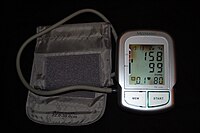
Photo from wikipedia
OBJECTIVES To investigate the effects of blood withdrawal on cardiac, hemodynamic, and pulmonary responses to submaximal exercise in females. DESIGN AND METHODS 30 healthy females (63.8 ± 8.3 years) were recruited for this… Click to show full abstract
OBJECTIVES To investigate the effects of blood withdrawal on cardiac, hemodynamic, and pulmonary responses to submaximal exercise in females. DESIGN AND METHODS 30 healthy females (63.8 ± 8.3 years) were recruited for this experimental study. Transthoracic echocardiography, non-invasive blood pressure monitoring, and oxygen uptake were assessed during a fixed submaximal workload (100 W) prior to (day 1) and immediately after (day 2) a 10% reduction of blood volume. Main measurements included left ventricular end-diastolic volume, stroke volume, cardiac output, mean arterial pressure, systolic blood pressure, diastolic blood pressure, and oxygen uptake. Blood volume was determined via carbon monoxide rebreathing. RESULTS Participant's blood volume ranged from 3.8 to 6.6 L. Following 10% reduction in blood volume (0.5 ± 0.1 L), left ventricular end-diastolic volume (p ≤ 0.030) and stroke volume (p < 0.019) were reduced during submaximal exercise while cardiac output was unchanged (p = 0.139) due to increased heart rate (p < 0.026). Hemodynamic variables including mean arterial pressure (p < 0.015), systolic blood pressure (p < 0.005), and diastolic blood pressure (p < 0.038) were reduced while oxygen uptake was unaltered (p = 0.250). CONCLUSIONS Blood withdrawal results in marked reductions in cardiac filling with compensatory chronotropic responses that preserve cardiac output at a moderate submaximal workload in healthy females. Thus, blood volume determines the relative exercise intensity, as typically determined by heart rate, of submaximal efforts in this population.
Journal Title: Journal of science and medicine in sport
Year Published: 2021
Link to full text (if available)
Share on Social Media: Sign Up to like & get
recommendations!